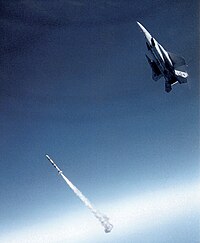Cynebury Accord
| Treaty Establishing Guidelines to Secure the Continued Peaceful Usage of Outer Space | |
|---|---|
| Drafted | November 10, 1975 |
| Signed | November 14, 1975 |
| Location | Cynebury |
| Effective | July 9, 1976 |
| Condition | 5 ratifications, including the depositary Governments |
| Depositary | Government of Tretrid |
| Languages |
|
| Full text | |
The Cynebury Accord, formally the Treaty Establishing Guidelines to Secure the Continued Peaceful Usage of Outer Space, is a treaty that establishes international space law. The treaty was first signed as a result of an international summit in Cynebury, Tretrid, on November 14, 1975.
The Cynebury Accord's main points are that it prohibits weaponizing space, limits the use of space for only peaceful purposes, and establishes that space is to be free for exploration and use by all nations, but no nation may claim sovereignty of outer space or any celestial body. The Cynebury Accord does not, however, prohibit the use of military satellites for non-combat roles.
Background


Concerns over the exploration of space first popped up amid the tensions of the Auroran Cold War, which brought the intercontinental ballistic missile (ICBM) into being. The Auroran Space Race, which used rockets derived from ICBMs, also lead to various proposals for the militarization of space, such as satellites in polar orbits carrying numerous independently warheads capable or orbital bombardment on a moments notice. As a countermeasure to such satellites, various proposals for anti-satellite (ASAT) weapons were created, some of which progressed into active development.

In the Auroran Imperial War, Noroist Axdel constructed and deployed the first such orbital bombardment weapon, named Kevatuul after a Kozam deity of the night sky. It was intended as a first strike system to attack military bases and fleets in case of a Morstaybishlian invasion of Axdel. However, in 1975, three Emberitian intelligence agents were discovered attempting to sabotage the weapon. As relations between the allies had been degrading since 1973, the agents were mistaken for Ethalrians, a suspicion exacerbated by a confrontation and communication breakdown between their leaderships. This incident led to an overzealous commanding officer having Kevatuul fire 6 missiles at Ribenstadt and its surrounding roads and railway lines leading into the city. The effect of this was devastating, as the warheads detonated in an airburst fashion to maximise their destructive effect. Ribenstadt was devastated, with millions left homeless and hundreds of thousands of civilians and soldiers alike were killed; both by the detonations and the subsequent unprecedented humanitarian disaster.
A cease-fire was immediately declared by Morstaybishlia in order to prevent further confusion, escalation and stop any retaliatory strikes. Talks between the belligerent nations of the AIW began, and as a result the Weyrciff Pact was signed later that year. As part of the peace agreement, Kevatuul was deorbited, breaking apart over the southern ocean where some debris was recovered
The destruction of Ribenstadt greatly heightened concerns over the future militarization of space, a fear that was compounded when, on October 2, the Tretridian Air Force performed the Steorran Spere (lit. 'Spear of Stars') test. In the test shot, an aircraft fired an ASAT missile, successfully destroying the target, a decommissioned research satellite. About 300 pieces of space debris was created from the destruction of the satellite in what would be the only recorded use or test of an ASAT weapon in history. Some pieces of debris from the test would persist in low Urth orbit until the 2000s.
Furthermore, a paper released about a month earlier proposed that the accumulation of space debris could be much more dangerous to space exploration than previously believed, through a proposed mechanism called collisional cascading. The high number of debris created by a single ASAT shot, along with the likely radiological hazard from the use of ASAT weapons against a station like Kevatuul, created fears that the militarization of space would not only endanger sapient life (as had been demonstrated by the Kevatuul strikes) but also endanger the future of spaceflight. These concerns culminated in the signing and eventual ratification of the Cynebury Accord.
Key points
The treaty established outer space as the "common domain of all urthkind," to be explored and used "on a basis of equality" and guaranteed "free access to all outer space" under Article I of the treaty. The following articles further emphasize that point, declaring all claims over space or celestial bodies null and void (Article II) and requiring the usage of space to be carried out in accordance with international law (Article III).
Any form of armament in outer space and ASAT weapons were prohibited by Article VI. Similarly, as "envoys of urthkind," astronauts were given protected status (Article V). These two provisions were a direct response to both orbital weapons like Kevatuul and the danger posed by ASAT weapons like the one used in Steorran Spere.
Under Article VI, states were given the responsibility of their activities in outer space (including by non-governmental entities) for the purposes of the Treaty and were therefore also liable for any damage caused by its activities under Article VII. These two articles were especially relevant in light of the Space Debris Crisis, as under the provisions of the treaty Vakarastan was found liable for both the mass destruction of satellites caused by the 2016 collisional cascade and resulting loss of life in Air Tavaris Flight 704.
Article XIV demanded the creation of the International Court of Outer Space (ICOS) to mediate disputes between states regarding the usage of space as well as to arbitrate matters regarding space law.